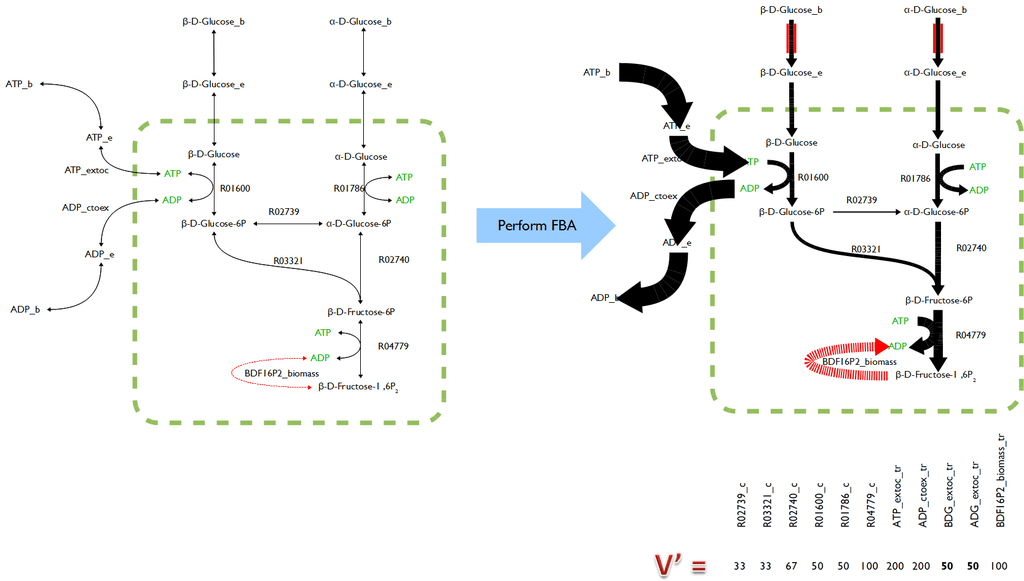What is the Difference Between Metabolic Flux Analysis and Flux Balance Analysis
The key difference between metabolic flux analysis and flux balance analysis is that metabolic flux analysis is an imaging fluxomics technique for analyzing production and consumption rates of metabolites in a biological system, while flux balance analysis is a mathematical fluxomics technique for analyzing the flow of metabolites through a metabolic network.
Fluxomics refers to various approaches used to determine the rates of metabolic reactions within a biological system. The significance of fluxomics is that metabolic fluxes usually determine cellular phenotypes. Metabolic flux is the metabolite conversion in a metabolic network. There are two important fluxomics or flux analysis technologies. They are metabolic flux analysis and flux balance analysis.
CONTENTS
1. Overview and Key Difference
2. What is Metabolic Flux Analysis
3. What is Flux Balance Analysis
4. Similarities – Metabolic Flux Analysis and Flux Balance Analysis
5. Metabolic Flux Analysis vs Flux Balance Analysis in Tabular Form
6. Summary – Metabolic Flux Analysis vs Flux Balance Analysis
Metabolic flux analysis (MFA) is an imaging fluxomics technique that analyzes the production and consumption rates of metabolites in a biological system. This technique allows for the quantification of metabolites at an intracellular level. Therefore, this technique elucidates the central metabolism of the cell. In metabolic flux analysis, the 13C fluxomics based method is commonly used for flux analysis. In 13C fluxomics, the metabolic precursors are enriched with 13C before introduction into the biological system. Later, using imaging techniques such as mass spectrometry and nuclear magnetic resonance spectroscopy, the level of incorporation of 13C into metabolites is measured.

In addition, metabolic fluxes can be measured with stoichiometry. In metabolic flux analysis, stoichiometric models and mass spectrometry methods determine the transfer of moieties containing isotopic tracers from one metabolite into another in a metabolic network. Thus, this technique can derive information about the entire metabolic network and cellular phenotype. Furthermore, metabolic flux analysis has many applications. This technique can determine the limits on the ability of a biological system in producing a biochemical agent such as ethanol. In addition to that, this technique can predict response to gene additions or knockouts.
What is Flux Balance Analysis?
Flux balance analysis (FBA) is a mathematical fluxomics technique that analyzes the flow of metabolites through a metabolic network. It is done via a two steps process. In the first step, metabolic reactions are represented mathematically in the form of a numerical matrix containing stoichiometric coefficients of each reaction. These stoichiometric coefficients impose constraints on the system model. By providing constraints like this, the possible sets of solutions to the system are reduced. In the second step, following the additions of constraints, the system model is optimized. Flux balance analysis calculates the flow of metabolites in a metabolic network by using the above mechanism. Hence, it is possible to predict the growth rate of an organism or the production rate of a biotechnologically important metabolite through FBA.

The resources for flux balance analysis include the BIGG database, COBRA toolbox, and FASIMU (FBA simulation software metabolomics). Flux balance analysis has diverse uses in physiological studies, gap filling efforts, and genome-scale synthetic biology. Furthermore, FBA can also be used to predict the yield of important cofactors such as ATP, NADH, or NADPH.
- Metabolic flux analysis and flux balance analysis are flux analysis technologies.
- Both techniques fall within the field of system biology
- These techniques can determine metabolic flux in a biological system.
- These techniques have wide applications.
- Both techniques can determine cell phenotype.
Metabolic flux analysis is an imaging fluxomics technique used to analyze production and consumption rates of metabolites in a biological system, while flux balance analysis is a mathematical fluxomics technique that analyzes the flow of metabolites through a metabolic network. So, this is the key difference between metabolic flux analysis and flux balance analysis. Furthermore, metabolic flux analysis uses mass spectrometry or nuclear magnetic resonance to determine metabolic fluxes, while flux balance analysis uses a mathematical (numerical) matrix to determine metabolic fluxes.
The following infographic lists the differences between metabolic flux analysis and flux balance analysis in tabular form for side by side comparison.
Summary – Metabolic Flux Analysis vs Flux Balance Analysis
Flux analysis (fluxomics) technologies are used to determine the rates of metabolic reactions within a biological system. There are two main flux analysis technologies. They are metabolic flux analysis and flux balance analysis. Metabolic flux analysis is an imaging fluxomics technique for analyzing production and consumption rates of metabolites in a biological system, while flux balance analysis is a mathematical fluxomics technique for analyzing the flow of metabolites through a metabolic network. Thus, this summarizes the difference between metabolic flux analysis and flux balance analysis.
Reference:
1. “Metabolic Flux Analysis.” An Overview | ScienceDirect Topics.
2. Orth, Jeffrey D, et al. “What Is Flux Balance Analysis?” Nature Biotechnology, U.S. National Library of Medicine, Mar. 2010.
Image Courtesy:
1. “Metabolic interactions between astrocytes and neurons with major reactions” from diagram in journal article (see source). Authors of article: Tunahan Cakir, Selma Alsan, Hale Saybasili, Ata Akin, Kutlu Ulgen – Cakir, Tunahan; Selma Alsan, Hale Saybasili, Ata Akin, Kutlu Ulgen (2007). “Reconstruction and flux analysis of coupling between metabolic pathways of astrocytes and neurons: application to cerebral hypoxia” – Theoretical Biology and Medical Modelling 4 (1): 48. DOI:10.1186/1742-4682-4-48. ISSN 1742-4682. Retrieved on 2007-12-17 (CC BY 2.0) via Commons Wikimedia
2. “Results of FBA maths” By Thomasf2811 – Own work (CC BY-SA 3.0) via Commons Wikimedia
ncG1vNJzZmivp6x7pbXFn5yrnZ6YsqOx07CcnqZemLyue9ahmK1lmah6tbTEZpuinpaav6a6wp5km52krLKmuoymnK2ZkqS5qq%2BMn6OusF2Wu6K42KygrGWRo7Fussuur2aakaGur6%2FEZpinmZyuwKq%2Fjg%3D%3D